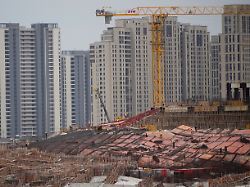Lots of bad news
Things are looking bleak for China’s economy
By Jan Ganger
06/15/2023, 6:30 p.m
China is weakening. Exports collapse, youth unemployment shoots to record levels. The country is only slowly coming out of the Corona hole.
Actually, China’s economy should recover strongly after the end of the tough corona measures. But things are not going well at all for Germany’s most important trading partner and the world’s second largest economy after the USA.
Last year, strict corona lockdowns with forced quarantines and the sealing off of entire districts, accompanied by a real estate crisis, had weighed heavily on the economy – gross domestic product grew by only three percent. The government has announced a growth target of five percent for this year. That too is very modest by Chinese standards.
Against this background, the economic data published over the past few days have one thing in common: they are worse than expected and show that the economic recovery from the first quarter has now lost significant momentum and that China is in economic difficulties.
The central bank drew the consequences on Thursday. It lowered the key interest rate for the first time in ten months. This shows how dissatisfied the Communist Party is with economic developments. With the rate hike, the central bank is trying to breathe more life into the ailing economy. However, the general expectation is that the government will implement further support measures in the coming weeks.
Every fifth young person without a job
At first glance, the data published today looks pretty good, and the increases appear considerable. Industrial production increased by 3.5 percent in May compared to the previous year. And retail sales — a key indicator of Chinese consumer sentiment — rose nearly 13 percent in May.
The problem with this: That is less than expected, and compared to April, the momentum is slowing down. Also, the numbers are skewed. The current data is compared with the very weak performance a year ago, when China also sent megacities into lockdown and corona lockdowns stalled the economy.
China is only slowly coming out of the Corona low. This is also shown by the Chinese real estate market, which has grown rapidly and far too much over the years and accounts for a large part of the economic output of the People’s Republic. After the imminent collapse of real estate developer China Evergrande, which was indebted to a volume of $300 billion, the market is only slowly getting back on its feet.
The labor market also gives no cause for optimism. The urban unemployment rate is 5.2 percent. The youth unemployment rate, which includes workers aged 16 to 24, is now at a record high of almost 21 percent.
Trade is shrinking
A rapid improvement in the economic situation is not in sight. Recently, China even had to cope with a weakness in the export machinery. Exports fell 7.5 percent year-on-year in May and imports shrank 4.5 percent.
The government wants to change the previous growth model, which relies on exports, and is focusing on domestic demand, especially private consumption. But the development is currently weaker than hoped. As a sign of the weak domestic market, imports fell in May for the second month in a row. The 4.5 percent decline is also worrying because the base of comparison was exceptionally low a year ago. At that time, the corona lockdown in Shanghai had largely brought China’s largest port to a standstill. Exports also collapsed, by 7.5 percent.
Another warning sign is weak inflation in China. Consumer prices rose by just 0.2 percent in May, which also suggests a bumpy economic recovery after the Corona crisis. Meanwhile, producer prices have been falling for eight months. They are an important indicator of further inflation. In the statistics, the prices are listed from the factory gate – i.e. before the products are further processed or sold. They thus give an early indication of how general consumer prices are developing. In May, they fell by 4.6 percent, the fastest in seven years.
